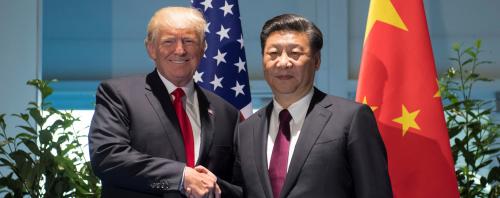Content from the Brookings-Tsinghua Public Policy Center is now archived. Since October 1, 2020, Brookings has maintained a limited partnership with Tsinghua University School of Public Policy and Management that is intended to facilitate jointly organized dialogues, meetings, and/or events.
China sees itself as progressing along a continuum that eventually returns it to the center of East Asia and a restoration of its role as a leading global power, writes Ryan Hass. As China’s relative power has grown, its desire to accelerate progress along this continuum has intensified. This piece originally appeared in The Asan Forum.
In recent years, particularly since Xi Jinping’s ascension to power, it has become commonplace for journalists and experts in the United States to describe China’s external behavior as growing increasingly assertive, even revisionist. Many commentators have attributed this shift to Xi, suggesting a causality between his leadership and China’s growing assertiveness. To many in the West, China’s rapid rise in national power is viewed as a challenge to the post-World War II international order, an order rooted in rules and norms that was designed to guard against a return of great power rivalries.
China’s own narrative of its rise, and of its historic identity, stands in contrast. China views its rise as leading to a restoration of the natural order of international relations, with China as the world’s largest economy and center of global power. China views its “century of humiliation” beginning with its loss to Western powers in the Opium War (1840-42) and its subsequent political subjugation and national fragmentation as a historic aberration, a stain on the country’s long and proud history, and a wrong in need of righting. The Chinese Communist Party drew on such sentiments for its founding in 1921, and it has nurtured this narrative as a central organizing principle for the past century.
Through education and propaganda, the Communist Party has juiced this narrative to spur citizens to work hard and return China to its past glory. It also has driven a narrative that the West and Japan are determined to keep China down, and that only the Communist Party is strong enough to guide China in overcoming outside pressure to become wealthy, powerful, and whole again.
Beijing sees itself as progressing along a continuum that leads eventually to China’s return to the center of East Asia and a restoration of its role as a leading global power. As China’s relative power has grown, its desire to accelerate progress along this continuum has intensified. President Xi is the latest leader seeking to push China toward its long-held goals.
In his first four-plus years as leader, Xi has proven adept at giving expression to China’s progress, and to the Communist Party’s purpose. He has summoned China’s 1.4 billion citizens to contribute to the “great rejuvenation of the Chinese nation,” and he has concentrated the Communist Party on two “centenary goals”: first, to double China’s GDP and per capita income relative to 2010 by the hundredth anniversary of the founding of the Chinese Communist Party in 2021 in order to make China a “moderately prosperous society”; and second, to turn China into a prosperous, strong, advanced country by the centenary of the founding of the People’s Republic of China in 2049.
The Brookings Institution is committed to quality, independence, and impact.
We are supported by a diverse array of funders. In line with our values and policies, each Brookings publication represents the sole views of its author(s).







Commentary
The trajectory of Chinese foreign policy: From reactive assertiveness to opportunistic activism
November 4, 2017